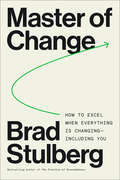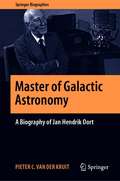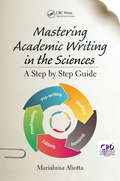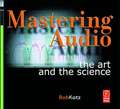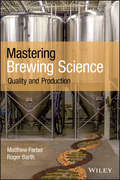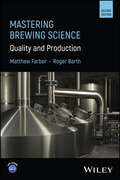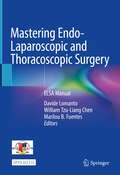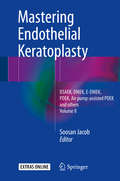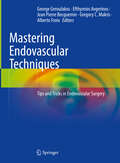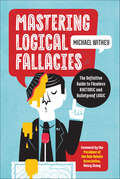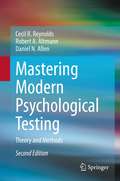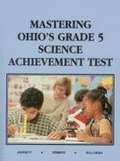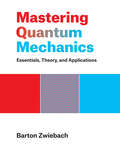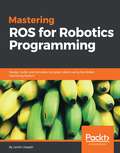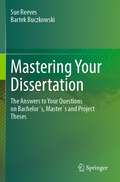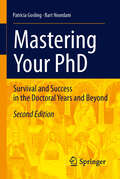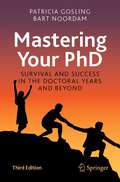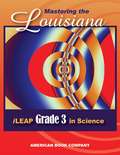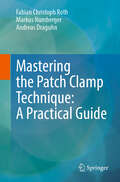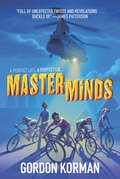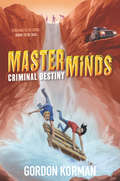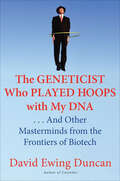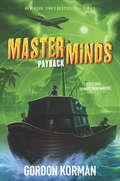- Table View
- List View
Master of Change: How to Excel When Everything Is Changing – Including You
by Brad StulbergA revelatory book on rethinking change and creating a rugged and flexible mindset amidst life's intensifying flux, from expert on sustainable excellence, coach, and bestselling author of The Practice of Groundedness.From social disruptions like economic recessions, pandemics, and new technologies to individual disruptions like getting married, career transitions, and becoming a parent, we undergo change and transformation—both good and bad—regularly. Change is not the exception, it’s the rule. Yet we endlessly fight it, often viewing it as a threat to our stability and sense of self.Master of Change flips this script on its head and offers a path for embracing and even growing from life’s constant instability.Brad Stulberg, sustainable excellence expert, coach, and bestselling author of The Practice of Groundedness, offers a new model that describes change as an ongoing cycle of order, disorder, and reorder—yes, we return to stability, but that stability is somewhere new. Drawing on modern science, ancient wisdom, and daily practice, Stulberg offers concrete principles for developing a mindset called rugged flexibility, along with habits and practices to implement it. Along the way, Stulberg reveals:How to be in conversation with change instead of it happening to you.The importance of expectationsWhy cultivating a rugged yet flexible sense of self is key to a strong identity.How to take productive action during a challenge.The paradox of both making meaning and moving forward.In the end, Stulberg reshapes our entire perception of change and shows us how to grow in its midst—ultimately helping us move forward better, stronger, and wiser than we were before.
Master of Galactic Astronomy: A Biography of Jan Hendrik Oort (Springer Biographies)
by Pieter C. van der KruitThis accessible and entertaining biography chronicles the life and triumphs of astronomer Jan Hendrik Oort, who helped lay the foundations of modern astronomy in the 20th century. The book puts into context some of Oort's most significant achievements, including his discovery that the Milky Way rotates, as well as his famous hypothesis that our Solar System is surrounded by a reservoir of comets — now simply known as the Oort Cloud. Written by Oort’s former student, this fascinating story also delves into Oort’s pivotal role in the foundation of major astronomical facilities, including radio telescopes in the Netherlands and the European Southern Observatory (ESO), which now operates the most successful astronomical observatories in the world. The book draws extensively on new archival research through the Oort Archives, along with personal reminiscences by Oort’s son and astronomer-grandson, to paint a more detailed picture of Oort’s life not just as an astronomer, but also as a husband, father, and citizen. The strong public interest in comets triggered by the Rosetta mission to comet 67P/Churyumov–Gerasimenko and the recently discovered interstellar comet in the Solar System make this book particularly timely.
Mastering Academic Writing in the Sciences: A Step-by-Step Guide
by Marialuisa AliottaThis book provides a comprehensive and coherent step-by-step guide to writing in scientific academic disciplines. It is an invaluable resource for those working on a PhD thesis, research paper, dissertation, or report. Writing these documents can be a long and arduous experience for students and their supervisors, and even for experienced researchers. However, this book can hold the key to success. Mapping the steps involved in the writing process - from acquiring and organizing sources of information, to revising early drafts, to proofreading the final product - it provides clear guidance on what to write and how best to write it. <P><P>Features: <li>Step-by-step approach to academic writing in scientific disciplines <li>Ideal guidance for PhD theses, papers, grant applications, reports and more <li>Includes worked-out examples from real research papers and PhD theses and templates and worksheets are available online to help readers put specific tasks into practice
Mastering Audio: The Art and the Science
by Bob KatzMastering Audio explains leading-edge audio concepts in an easy-to-grasp, holistic manner, including an ear-opening investigation of the mysteries of jitter, dither and wordlengths, high sample rates, distortion, headroom, monitor calibration, metering, depth perception, compression and expansion, equipment interconnection and much more. Mastering Audio is for everyone who wants to increase their mastery of digital and analog audio: musicians, producers, A&R, mastering, recording and mixing engineers, and students.
Mastering Brewing Science: Quality and Production
by Roger Barth Matthew FarberMastering Brewing Science is a comprehensive textbook for the brewing industry, with coverage of processes, raw materials, packaging, and everything in between, including discussion of essential methods in quality control and assurance. The book equips readers with a depth of understanding to deal with problems and issues that arise during production of beer from start to finish, as well as statistical tools for continual quality improvement. Brewery operations, raw material analysis, flavor, stability, cleaning, and methods of quality control, as well as the underlying science, are discussed in detail. The successful brewing professional must produce beer with high standards of quality, consistency, efficiency, and safety. With a focus on quality and on essential applications of biology, chemistry, and process control, Mastering Brewing Science places emphasis on troubleshooting and reader understanding. It is the ideal learning tool for all brewing programs or as a resource for current industry professionals. Features of Mastering Brewing Science include: Understanding through application. All key principles of science are applied to the brewing process, facilitating a better understanding of both. Check for Understanding. Each chapter includes a set of problems and questions that reinforce understanding of the material. Problem-solving. Several chapters conclude with practical case studies from real-world brewing experiences to further develop concepts through application of problem-solving skills. Comprehensive. Presented in the logical order of the brewing process, the book covers all aspects of raw materials, wort preparation, fermentation, conditioning, and packaging. Richly illustrated. Hundreds of unique, full-color illustrations, ranging from micrographs of spoilage bacteria to the inner workings of a beer keg, supplement clearly-written text, making this book easy to understand and appealing to the reader. Emphasis on Quality. Covers the underlying science and essential methods in quality control with discussion of data management and experimental statistics to ensure consistency in beer production. Safety. Safety notes for brewing operations prepare the reader for a culture of safety at the workplace. Glossary. A detailed and authoritative glossary with over 1,700 entries sets the standard for beer and brewing terminology. References. Each chapter includes key references to
Mastering Brewing Science: Quality and Production
by Roger Barth Matthew FarberFocused on brewing science, process, and quality, this is a comprehensive textbook on beer production, from the underlying biology and chemistry to process steps, packaging, testing, and service of beer and related products. Mastering Brewing Science is a complete resource for brewing students as well as established professionals, with coverage of brewing processes, beer quality assurance, and related industries such as hop and malt preparation. The text strikes a balance among essential scientific concepts, treatment of raw materials, procedures and equipment for beer brewing, and protecting and evaluating product quality. Understanding the science of beer production will enable readers to troubleshoot problems in the brewery, a critical skill for a career in beer. Mastering Brewing Science begins with a high‐level discussion of the brewing process. Subsequent chapters review the fundamentals of biology and chemistry with application to the brewing process. The remaining material covers the processes and procedures to make quality beer and related beverages, including a focus on each of the four raw materials. Hundreds of illustrations, many in full color, explain the equipment and processes. The newly revised and updated Second Edition of Mastering Brewing Science includes: End-of-chapter review questions.Twenty-six “Case Studies” focused on real-world, practical problems for discussion.Coverage of alternative beverages including low alcohol beer, gluten-free beer, flavored malt beverages, hard seltzer, hemp beer, high-gravity brewing, and brewing with bacteria.Expanded coverage of water, malt, hops and yeast, each with its own chapter.Techniques for effective standard operating procedures (SOPs).Strong coverage of workplace safety throughout, with all safety coverage tabulated together in the index.Many procedures for beer preparation and quality testing of beer, raw materials, and packaging. All procedures are tabulated in the index. Mastering Brewing Science is an essential learning resource for students in brewing science or technology programs or as a valuable resource for brewing professionals.
Mastering Endo-Laparoscopic and Thoracoscopic Surgery: ELSA Manual
by Rakesh Gupta Alembert Lee-Ong Emily Rose Nery Michael Lawenko Eva Lourdes Sta. Clara Marilou Blancos Fuentes Siau Wei Tang Narendra Agarwal Asim Shabbir Jaideep Rao Rajat Goel Le Quan Anh Tuan Henry Chua Kiyotaka Imamura Enrico Lauro Hrisikesh Salgaonkar William Tzu-Liang Chen Sajid MalikThis is an open access book.The book focuses mainly on the surgical technique, OR setup, equipments and devices necessary in minimally invasive surgery (MIS). It serves as a compendium of endolaparoscopic surgical procedures. It is an official publication of the Endoscopic and Laparoscopic Surgeons of Asia (ELSA).The book includes various sections covering basic skills set, devices, equipments, OR setup, procedures by area. Each chapter cover introduction, indications and contraindications, pre-operative patient’s assessment and preparation, OT setup (instrumentation required, patient’s position, etc.), step by step description of surgical procedures, management of complications, post-operative care. It includes original illustrations for better understanding and visualization of specific procedures.The book serves as a practical guide for surgical residents, surgical trainees, surgical fellows, junior surgeons, surgical consultants and anyone interested in MIS. It covers most of the basic and advanced laparoscopic and thoracoscopic surgery procedures meeting the curriculum and examination requirements of the residents.
Mastering Endothelial Keratoplasty
by Soosan JacobVolume 2 of this edited book covers management of complex situations and complications. Topics such as combined surgeries, EK in complex situations, management of complications, graft management, and RHO-associated kinase (Rock) inhibitors have been covered as well. Basics and various surgical techniques have been covered in Volume 1 of Mastering Endothelial Keratoplasty. Endothelial keratoplasty is a field of great interest to all corneal surgeons. It is an exciting and evolving field in corneal transplantation as the newer techniques of DSAEK, DMEK, E-DMEK and PDEK have inherent advantages that make them supersede the older techniques by far. Hence, in today's scenario with the clearly superior results that these techniques offer, it is imperative for all corneal surgeons to learn them and know everything about managing the patient from the pre-operative to the postoperative period. This two-volume book is a must-read for the beginner as well as the established ophthalmologist with interest in corneal transplantation. It is also a must-have for educational institutions, hospital- based libraries and for post-graduate students, fellows and residents who want to expand their knowledge.
Mastering Endovascular Techniques: Tips and Tricks in Endovascular Surgery
by George Geroulakos Efthymios Avgerinos Jean Pierre Becquemin Gregory C. Makris Alberto FroioThis book provides a detailed practically applicable guide to using the latest endovascular techniques. Chapters feature detailed step-by-step instructions on how to perform procedures relevant for instances of disorders including cerebrovascular disease, splachnic arteries, and aortic aneurysms. Multiple choice questions are provided throughout to enable the reader to identify the points covered. Mastering Endovascular Techniques: Tips and Tricks in Endovascular Surgery describes the latest endovascular methodologies and features detailed insight on how to apply these techniques into day-to-day clinical practice.
Mastering Logical Fallacies: The Definitive Guide to Flawless Rhetoric and Bulletproof Logic
by Michael Withey"If I have learned anything in ten years of formal debating, it is that arguments are no different: without a good understanding of the rules and tactics, you are likely to do poorly and be beaten."—HENRY ZHANG, President of the Yale Debate AssociationYour argument is valid and you know it; yet once again you find yourself leaving a debate feeling defeated and embarrassed. The matter is only made worse when you realize that your defeat came at the hands of someone's abuse of logic—and that with the right skills you could have won the argument.The ability to recognize logical fallacies when they occur is an essential life skill. Mastering Logical Fallacies is the clearest, boldest, and most systematic guide to dominating the rules and tactics of successful arguments. This book offers methodical breakdowns of the logical fallacies behind exceedingly common, yet detrimental, argumentative mistakes, and explores them through real life examples of logic-gone-wrong.Designed for those who are ready to gain the upper hand over their opponents, this master class teaches the necessary skills to identify your opponents' misuse of logic and construct effective, arguments that win. With the empowering strategies offered in Mastering Logical Fallacies you'll be able to reveal the slight-of-hand flaws in your challengers' rhetoric, and seize control of the argument with bulletproof logic.
Mastering Modern Psychological Testing: Theory and Methods
by Cecil R. Reynolds Daniel N. Allen Robert A. AltmannThis book provides a comprehensive introduction to psychological assessment and covers areas not typically addressed in existing test and measurements texts, such as neuropsychological assessment and the use of tests in forensics settings. The book introduces the vocabulary of the profession and the most basic mathematics of testing early as being fundamental to understanding the field. Numerous examples are drawn from tests that the authors have written or otherwise helped to develop, reflecting the authors’ deep understanding of these tests and their familiarity with problems encountered in test development, use, and interpretation. Following the introduction of the basic areas of psychometrics, the book moves to areas of testing that represent various approaches to measuring different psychological constructs (memory, language, executive function, etc.), with emphasis on the complex issue of cultural bias in testing. Examples of existing tests are given throughout the book; however, this book is not designed to prepare students to go out and administer, score, and interpret specific psychological tests. Rather, the purpose of this book is to provide the foundational core of knowledge about tests, measurement, and assessment constructs, issues, and quantitative tools.Explains what constitutes a psychological test, how tests are developed, how they are best used, and how to evaluate their strengths and weaknesses;Describes areas of testing that represent different approaches to measuring different psychological constructs;Explains applications of psychological testing to issues in the courts;Addresses how test authors and publishers design and research tests to address the difficult and demanding issues of cultural differences in test performance and interpretation of test results.
Mastering Ohio's Grade 5 Science Achievement Test
by James Killoran Stuart Zimmer Mark JarrettThis book provides a complete "refresher" of the knowledge and skills you will need to do your best on the Grade 5 Science Achievement Test. The main part of the book consists of four units. Each of these units examines a different Ohio science standard and its benchmarks.
Mastering Quantum Mechanics: Essentials, Theory, and Applications
by Barton ZwiebachA complete overview of quantum mechanics, covering essential concepts and results, theoretical foundations, and applications.This undergraduate textbook offers a comprehensive overview of quantum mechanics, beginning with essential concepts and results, proceeding through the theoretical foundations that provide the field&’s conceptual framework, and concluding with the tools and applications students will need for advanced studies and for research. Drawn from lectures created for MIT undergraduates and for the popular MITx online course, &“Mastering Quantum Mechanics,&” the text presents the material in a modern and approachable manner while still including the traditional topics necessary for a well-rounded understanding of the subject. As the book progresses, the treatment gradually increases in difficulty, matching students&’ increasingly sophisticated understanding of the material. • Part 1 covers states and probability amplitudes, the Schrödinger equation, energy eigenstates of particles in potentials, the hydrogen atom, and spin one-half particles• Part 2 covers mathematical tools, the pictures of quantum mechanics and the axioms of quantum mechanics, entanglement and tensor products, angular momentum, and identical particles.• Part 3 introduces tools and techniques that help students master the theoretical concepts with a focus on approximation methods.• 236 exercises and 286 end-of-chapter problems• 248 figures
Mastering ROS for Robotics Programming
by Lentin JosephDesign, build and simulate complex robots using Robot Operating System and master its out-of-the-box functionalities About This Book * Develop complex robotic applications using ROS for interfacing robot manipulators and mobile robots with the help of high end robotic sensors * Gain insights into autonomous navigation in mobile robot and motion planning in robot manipulators * Discover the best practices and troubleshooting solutions everyone needs when working on ROS Who This Book Is For If you are a robotics enthusiast or researcher who wants to learn more about building robot applications using ROS, this book is for you. In order to learn from this book, you should have a basic knowledge of ROS, GNU/Linux, and C++ programming concepts. The book will also be good for programmers who want to explore the advanced features of ROS. What You Will Learn * Create a robot model of a Seven-DOF robotic arm and a differential wheeled mobile robot * Work with motion planning of a Seven-DOF arm using MoveIt! * Implement autonomous navigation in differential drive robots using SLAM and AMCL packages in ROS * Dig deep into the ROS Pluginlib, ROS nodelets, and Gazebo plugins * Interface I/O boards such as Arduino, Robot sensors, and High end actuators with ROS * Simulation and motion planning of ABB and Universal arm using ROS Industrial * Explore the ROS framework using its latest version In Detail The area of robotics is gaining huge momentum among corporate people, researchers, hobbyists, and students. The major challenge in robotics is its controlling software. The Robot Operating System (ROS) is a modular software platform to develop generic robotic applications. This book discusses the advanced concepts in robotics and how to program using ROS. It starts with deep overview of the ROS framework, which will give you a clear idea of how ROS really works. During the course of the book, you will learn how to build models of complex robots, and simulate and interface the robot using the ROS MoveIt motion planning library and ROS navigation stacks. After discussing robot manipulation and navigation in robots, you will get to grips with the interfacing I/O boards, sensors, and actuators of ROS. One of the essential ingredients of robots are vision sensors, and an entire chapter is dedicated to the vision sensor, its interfacing in ROS, and its programming. You will discuss the hardware interfacing and simulation of complex robot to ROS and ROS Industrial (Package used for interfacing industrial robots). Finally, you will get to know the best practices to follow when programming using ROS. Style and approach This is a simplified guide to help you learn and master advanced topics in ROS using hands-on examples.
Mastering Your Dissertation: The Answers to Your Questions on Bachelor´s, Master´s and Project Theses
by Sue Reeves Bartek BuczkowskiThis reader-friendly guide is specifically designed for any student who has ever had a question about theses as part of their university undergraduate degree course in a life- or health science-related subject. It covers the varied types of projects that exist, including experimental work, surveys, meta-analyses, audits and qualitative and quantitative studies - all in one place.Get support at planning, completing and writing of your research based thesis. By using examples and check lists, this book leads you through the entire process encompassing each chapter of the dissertation. Let the question and answer writing style encourage you and boost your confidence when embarking on what is probably your largest piece of work to date, solved in a step by step approach.The experienced authors have run an enormous number of web and face-to-face workshops to support students in life and health sciences and help them write their dissertations. It became clear that research theses are a considerable source of anxiety and that many essential questions need answering - this book is your solution.
Mastering Your PhD
by Lambertus D. Noordam Patricia Gosling"Mastering Your PhD: Survival and Success in the Doctoral Years and Beyond" helps guide PhD students through their graduate student years. Filled with practical advice on getting started, communicating with your supervisor, staying the course, and planning for the future, this book is a handy guide for graduate students who need that extra bit of help getting started and making it through. While mainly directed at PhD students in the sciences, the book's scope is broad enough to encompass the obstacles and hurdles that almost all PhD students face during their doctoral training. Who should read this book? Students of the physical and life sciences, computer science, math, and medicine who are thinking about entering a PhD program; doctoral students at the beginning of their research; and any graduate student who is feeling frustrated and stuck. It's never too early -- or too late! This second edition contains a variety of new material, including additional chapters on how to communicate better with your supervisor, dealing with difficult people, how to find a mentor, and new chapters on your next career step, once you have your coveted doctoral degree in hand.
Mastering Your PhD: Survival and Success in the Doctoral Years and Beyond
by Patricia Gosling Bart NoordamThis bestselling book guides PhD students through their graduate years and beyond. Filled with practical advice on getting started, communicating with your supervisor, staying the course, and planning for the future, this book is an indispensable guide for graduate students who need that extra bit of help getting started and making it through. Who should read this book? Any student currently in, or curious about, a PhD programme, be it in the physical and life sciences, engineering, computer science, math, medicine, or the humanities — this book tackles the obstacles and hurdles that almost all PhD students face during their doctoral training. Whether you’re at the very beginning of your research, close to the end, or just feeling frustrated and stuck at any point in between…it’s never too early — or too late — to focus on your success! This third edition contains a variety of new material, including additional chapters and advice on how to make the most of remote learning, collaboration, and communication tools, as well as updated material on your next career step once you have your coveted doctoral degree in hand. Some of the material in the third edition appeared as part of a monthly column on the ScienceCareers website.
Mastering the Louisiana iLeap Grade 3 in Science
by Michelle GunterThis book contains several sections. These sections are as follows: 1) general information about the book; 2) a diagnostic test and evaluation chart; 3) chapters that teach the concepts and skills that improve readiness for the iLeap Grade 3 Science Test; 4) two practice tests.
Mastering the Patch Clamp Technique: A Practical Guide
by Markus Numberger Andreas Draguhn Fabian Christoph RothThe patch clamp technique is one of the most important electrophysiological methods in use today. Its application in basic biomedical research has provided significant insights into the function and properties of ion channels, making it equally indispensable in applied pharmacological research. This book is the English edition of the popular German introduction to the patch clamp technique. This introductory book serves as a practical guide for teachers and students, offering clear and practical instructions on patch clamp recordings. The authors provide essential information to establish and successfully apply this method in the laboratory. The book covers the basics of measurements, the detailed setup of a patch clamp rig and how to carry out typical recordings. It also includes concrete tips and tricks to help with troubleshooting, making it an indispensable resource. The book not only highlights the enormous potential of the method for the study of ion channels and cell signaling, but also provides an introduction to the major developments and variations of the technique. The book is aimed at advanced students of biology, biochemistry, medicine, pharmacy and related disciplines as well as scientists who want to better understand and/or acquire the technique.
Mastering the TEKS in World Geography
by James Killoran Stuart Zimmer Mark JarrettLearn all about World Geography in this book. About the earth, its resources, climate, and physical features.
Masterminds (Masterminds #1)
by Gordon Korman<P>Action-packed and full of unexpected twists, this new series from New York Times bestselling author Gordon Korman is perfect for young fans of James Patterson and John Grisham. <P>Eli Frieden lives in the most perfect town in the world: Serenity, New Mexico. In this idyllic place, every lawn is perfectly manicured and everyone has a pool and a tree house. Honesty and integrity are valued above all else. The thirty kids who live there never lie--they know it's a short leap from that to the awful problems of other, less fortunate places. <P>Eli has never left Serenity . . . Why would he ever want to? Then one day he bikes to the edge of the city limits and something so crazy and unexpected happens, it changes everything. Eli convinces his friends to help him investigate further, and soon it becomes clear that nothing is as it seems in Serenity. The clues mount to reveal a shocking discovery, connecting their ideal crime-free community to some of the greatest criminal masterminds ever known. The kids realize they can trust no one--least of all their own parents. <P><b> Nominee for the 2018 Young Reader's Choice Award </b> <i>(Pacific Northwest Library Association)</i>
Masterminds: Criminal Destiny (Masterminds #2)
by Gordon Korman<P>The second book in the acclaimed, action-packed series from New York Times bestselling author Gordon Korman. <P>The clones of Project Osiris are free--but they're being hunted. . . . After their narrow escape from their "perfect" hometown, Eli, Tori, Amber, and Malik are finally in the real world and determined to expose the leaders of Serenity. They decide to track down Tamara Dunleavy, the mysterious billionaire and founder of Project Osiris. Evading capture by breaking laws and sneaking into houses, hotels, buses, and cars--are they becoming the criminals they were destined to be? <P>What they discover will change everything, leading them straight into the Plastic Works and the heart of the experiment, in order to uncover the deadly criminals they're cloned from--and any evidence that will convince the outside world to believe the truth. But the outside world isn't exactly what they expected--strangers aren't just unfriendly, they're dangerous. And the wrong move could send them right back into the arms of Dr. Hammerstrom--and trapped in Serenity for good.On a breakneck journey from Jackson Hole to a maximum security prison--Eli, Tori, Amber, and Malik will stop at nothing to take Project Osiris down. <P><b> Nominee for the 2018 Young Reader's Choice Award </b> <i>(Pacific Northwest Library Association)</i>
Masterminds: Genius, DNA, and the Quest to Rewrite Life
by David Ewing DuncanJames Watson, J. Craig Venter, Francis Collins, Cynthia Kenyon . . . you may not know them, but you should. They are the masterminds of genetics and biotechnology who want you to live to be 150 years old, to regenerate your heart and brain, to create synthetic life. For better or worse, they are about to alter life on earth forever.Award-winning journalist David Ewing Duncan tells the remarkable stories of cutting-edge bioscientists, revealing their quirky, uniquely fascinating, sometimes vaguely unsettling personas as a means to understand their science and the astonishing implications of their work. This book seamlessly combines myth, biography, scholarship, and wit that poses the all-important question: Can we actually trust these masterminds?
Masterminds: Payback (Masterminds #3)
by Gordon Korman<P>The thrilling finale to the New York Times-bestselling Masterminds series from middle grade star author Gordon Korman. Perfect for fans of Rick Riordan and James Patterson. <P>After a serious betrayal from one of their former friends, the clones of Project Osiris are on the run again. Now separated into pairs, Eli and Tori and Amber and Malik are fighting to survive in the real world.Amber and Malik track down the one person they think can help them prove the existence of Project Osiris, notorious mob boss Gus Alabaster, also known as Malik’s DNA donor. But as Malik gets pulled into the criminal world—tantalized by hints of a real family—his actions put him and Amber into greater danger. <P>Eli and Tori get sucked into even bigger conspiracies as they hunt down Project Osiris’s most closely guarded secrets—who does Eli’s DNA come from? With a surprising new ally and another cross-country adventure, the four will have to work together to overcome the worst parts of themselves if they are going to end Project Osiris once and for all. <P><b> Nominee for the 2018 Young Reader's Choice Award </b> <i>(Pacific Northwest Library Association)</i>
Masterminds: Profiles of Eleven Indian Scientists
by Enakshi ChatterjeeAn introduction to the life and work of eleven Indian scientists is told against the background of political and scientific developments over the last hundred and fifty years. Their interesting personal experiences are also revealed.
